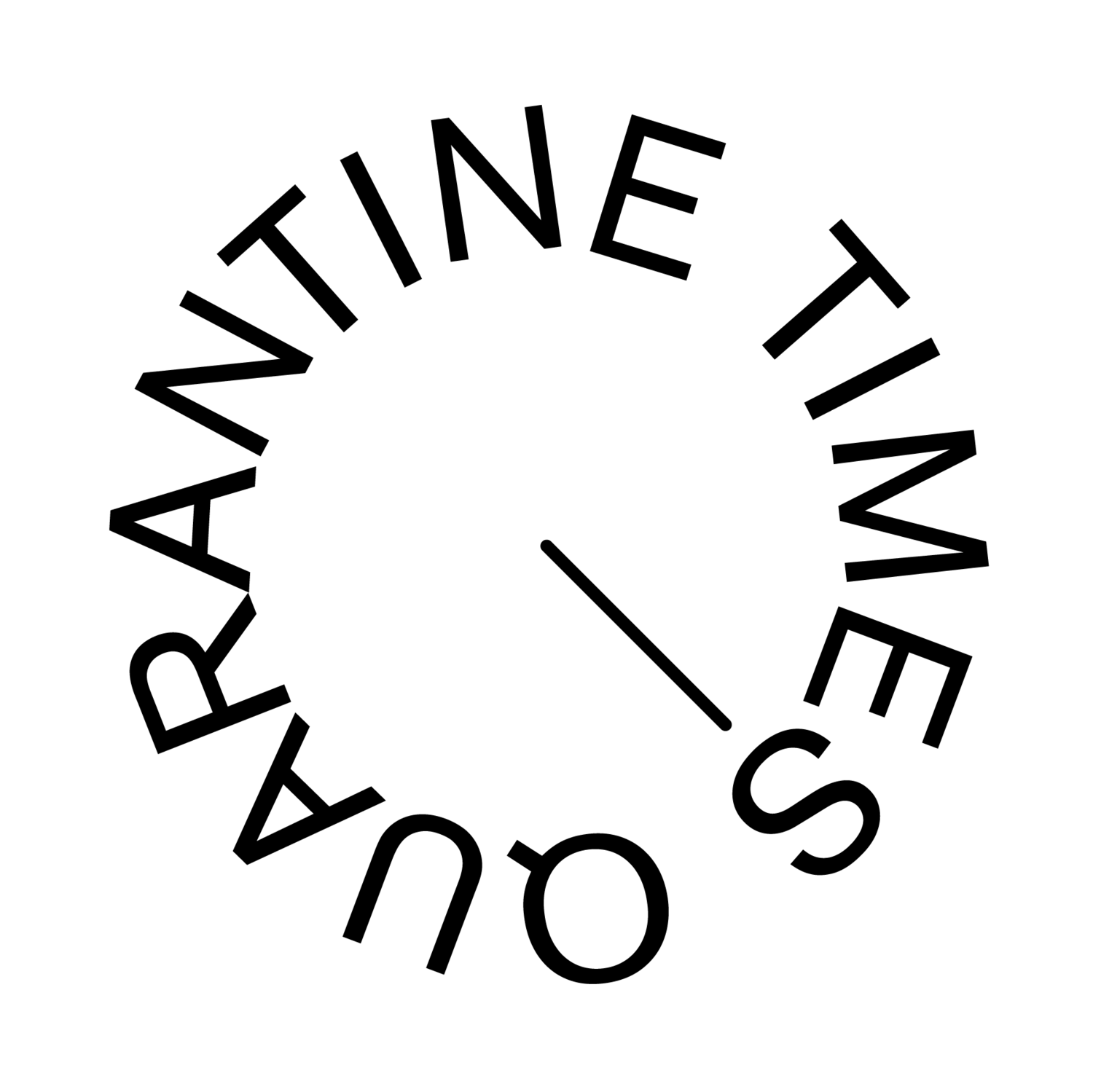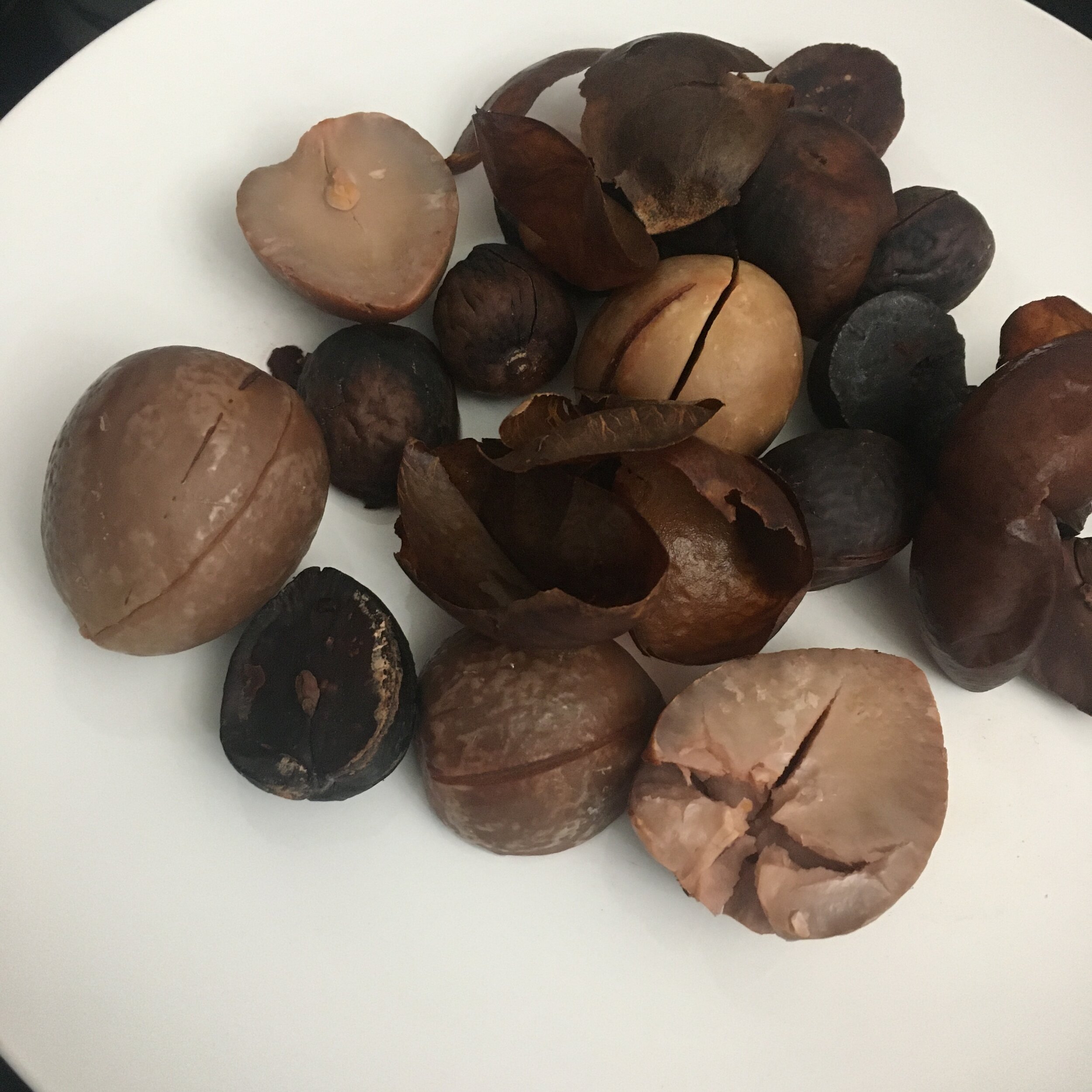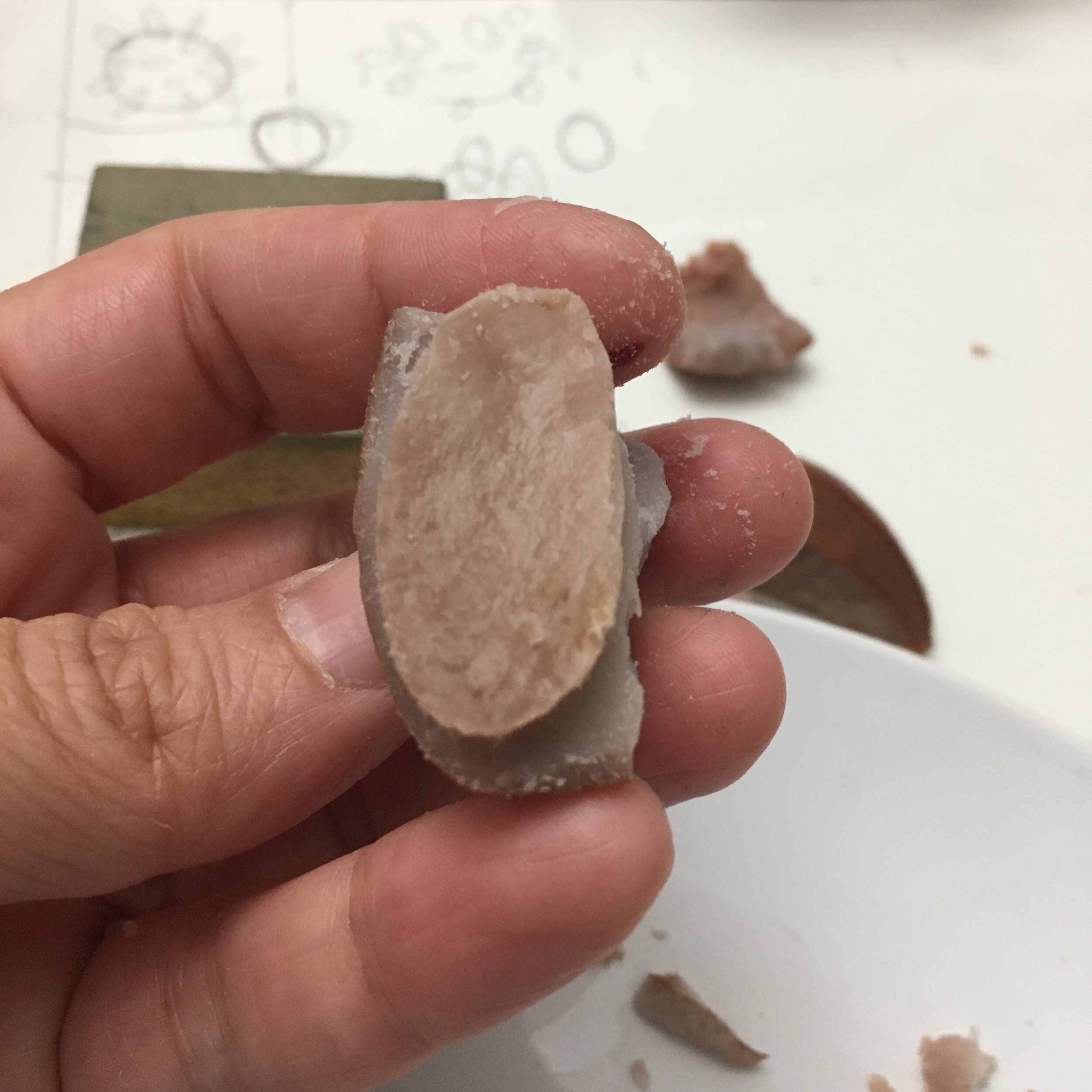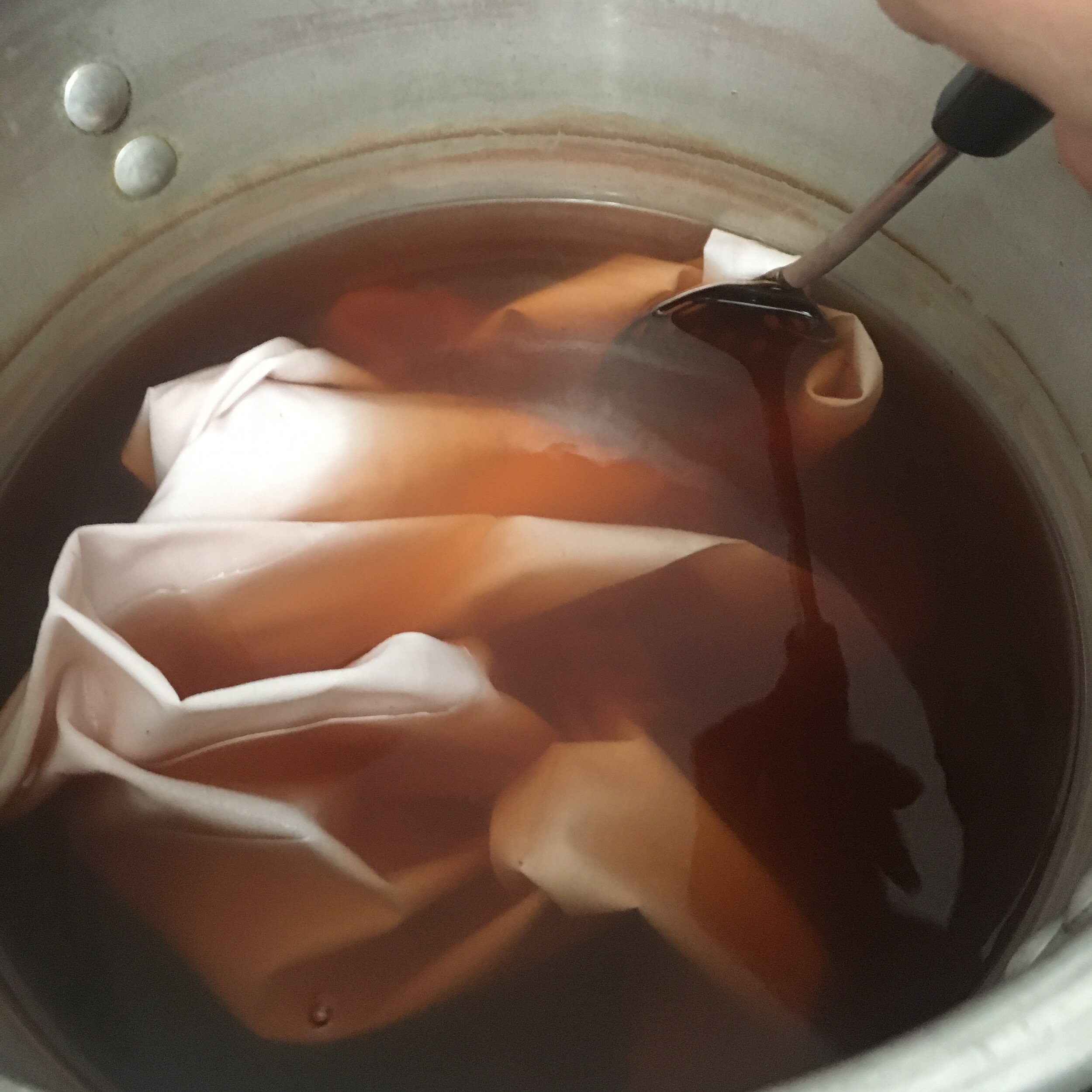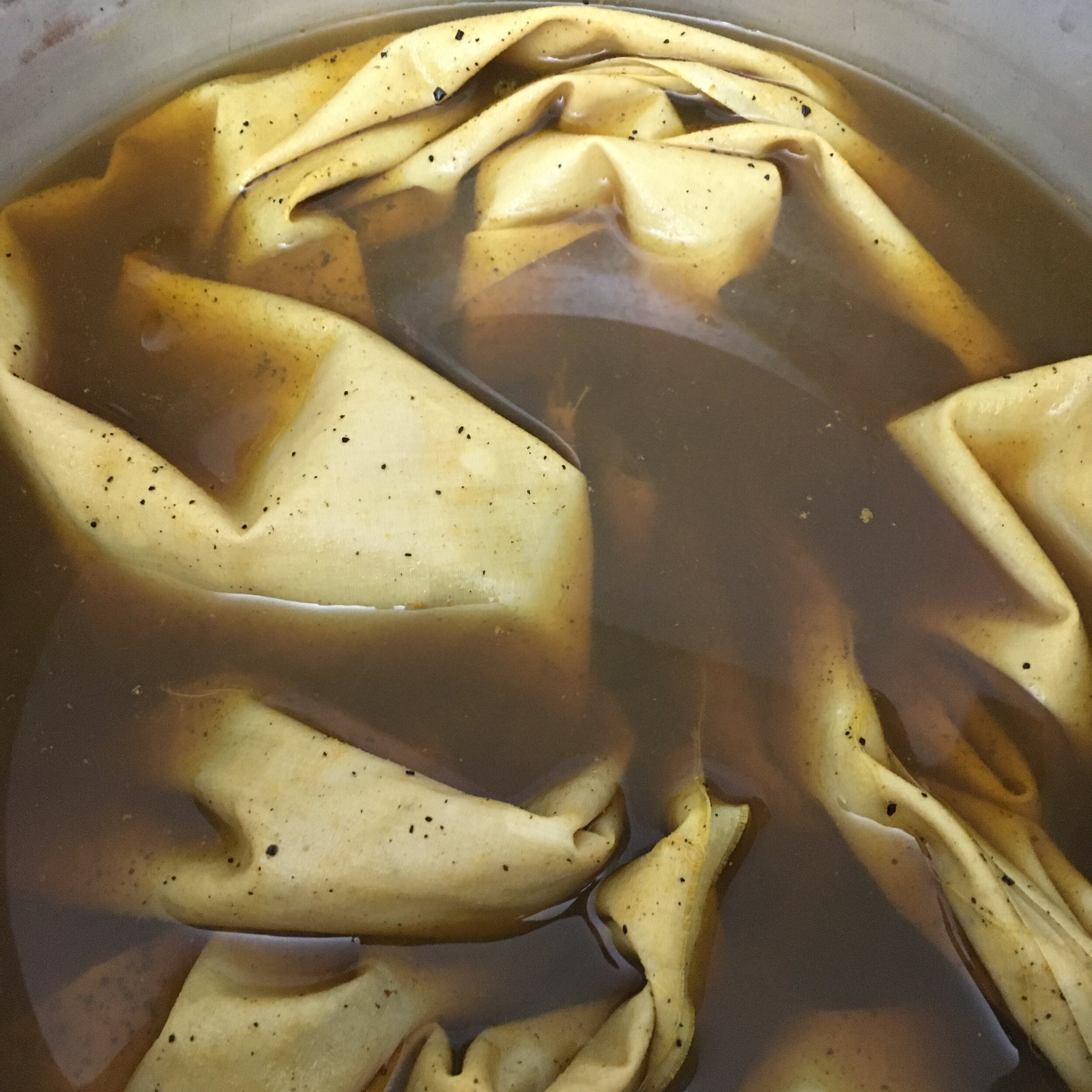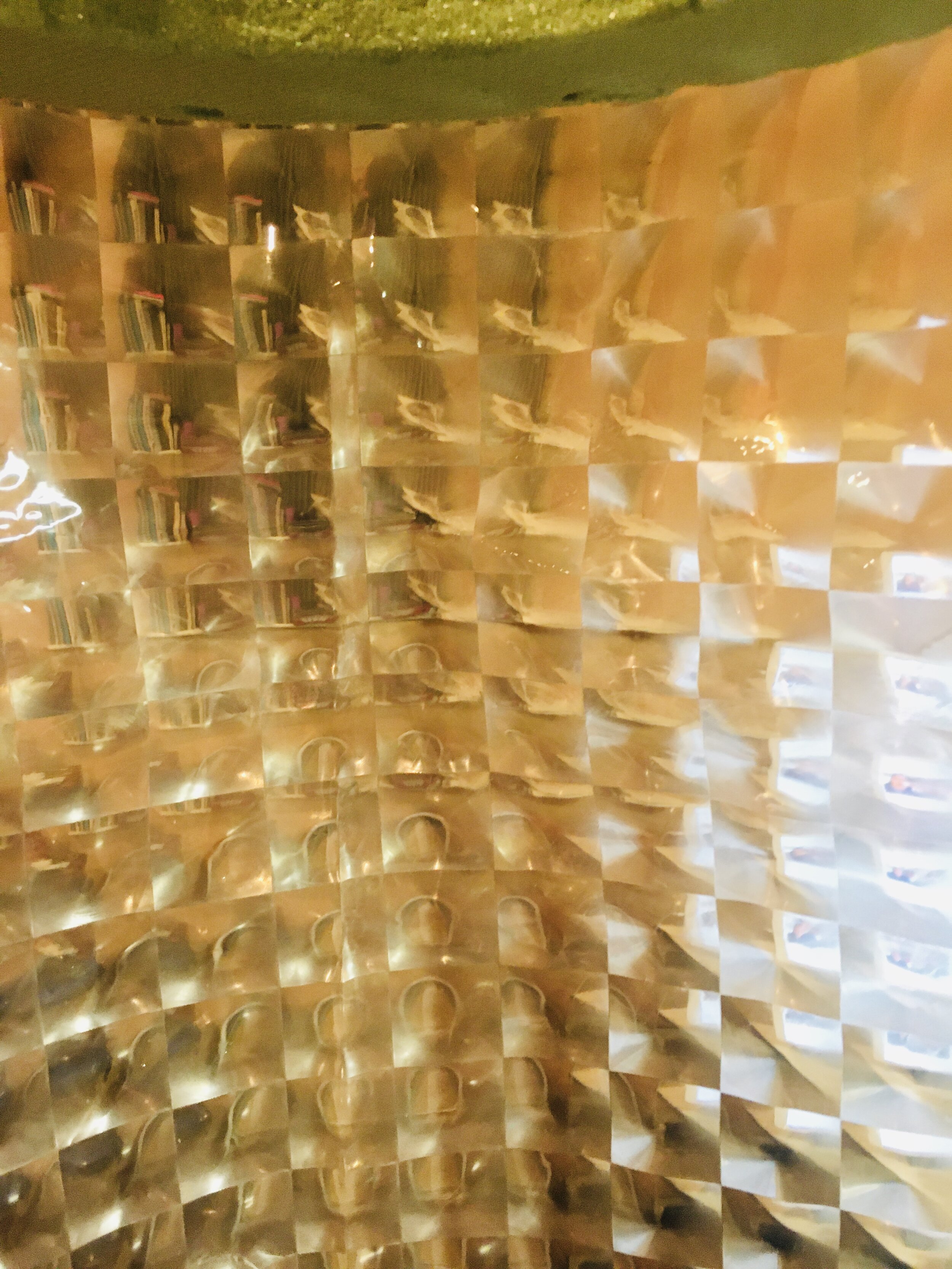The Revolution of an Evolution
04/14/20
by Betty Heredia
The printed material I had envisioned to create did not go as planned. Amid a pandemic, unemployed and sheltering in place, I looked around my home. What can I use to print with? What materials do I have to print on? What are my resources? What do I know? What can I do? I had a little less than a yard of plain, white, thin cotton blend material, gifted to me from a friend who knew I was sewing masks for friends. This material is too thin for a mask, as data shows that 100% cotton, non-woven material works best if at all, to suppress the spread of COVID-19. I have avocado pits, a few are fresh, the rest have been sitting in old coffee tin containers and jars for years. Some would say these are hoarded pits. I beg to differ however, these are pits shelved from one of my earlier installation works. Just as a painting is never complete, nor are ideas. Particularly mine.
Turmeric stained, printed & hand painted cotton blend fabric with mask.
Life is an evolution, am I right?
For months I had been practicing something called gratitude. During the holidays I was becoming aware how miserable I am. I wanted changes, I wanted something, I want, I want, I want. I was miserable and tired of feeling miserable.
So, I started with gratitude. I began and ended every day thankful for my health, my warm bed, clean running water, for being able to eat…. I was overwhelmed with joy so much that the Catholic Latina in me became a bit suspicious of my own happiness. COVID-19 was already in the news, but it was so far away from our US shores. I look back now and ask myself if I subconsciously knew that it would be best to begin shifting my perspective by acknowledging gratitude as a ritual for the days to come.
What day was it when I lost my jobs?
Governor Pritzker had issued that all bars and restaurants be closed for in-dining purposes. While I was upset, I was also relieved. Now I remember, it was St. Patrick’s weekend. I had worked that whole weekend trying to earn as much money as I could, assuming that closures would happen soon. I had worked a sold-out show that Thursday. The air felt tainted and heavy that weekend. At work, my hands were on fire between wiping down surfaces with bleach and washing my hands between every interaction. It was more than the usual food safety guidelines; it was as if we were battling this invisible presence from blanketing our skin, our food, our drinks, so that it can wait for any of us to touch our face. This invisible enemy, a virus, more omnipotent than an individual’s self determination, was putting a real dent in my plans.
My plans were to take all my experience as a visual artist, as a sound collage artist, and as an exhibitions preparator --having worked at the Chicago History Museum-- to execute an idea I had been playing for some time. I had a plan; a plan that had a budget and that required materials. Now, would I have to wait to carry out this plan? Because at this point, I have more pressing matters to tend to, such as survival.
(L) Avocado pits used to create dye. (R) A carved avocado pit to be used for printing.
The world is now halved to a ‘Before’ and an ‘After.’ In the ‘Before’ world, I often fantasize of revolution. I thought of the political climate in this country, of our choices to beat out Trump. I imagined as I did when I was an idealist teenager, a Utopian world. I thought that the only way for a new world, a better world to emerge, the old must die. I wondered if such a thing could ever happen without some conditioned thought from the old world influencing an imagined new world.
Is destruction the only way to open a path for a revolution? As many as there are people suffering, there are too many that are comfortable. I mused about the idea of a revolution occurring first within the individual, before any large-scale revolutions could take place. I ask myself often what my contributions to this world are. I am afraid of being a beast at the trough; I don’t want to live always on the take.
However, what can I do? I can start with my own revolution. How will that look? What does that involve? I can begin by questioning my conditioning. I can begin with confronting myself, even the part of me that is a beast at the trough. I was on the brink of my own revolution, I thought, as I practiced gratitude, but now I see it was not enough. For revolution to occur in this country, we must let go of our conditioning. We must understand, as individuals, the only permanence is impermanence. The times are asking, demanding, that we let go. What should remain with us long after the vaccine is made available for all of us? What will we let go or even forget in better times?
These are musings I’ve been afforded to have. I am one of the lucky ones even if I am unemployed. I still have a bed, I still have running clean water, I have food, I have a home, I have good health. I am a rich person in that regard.
(L) Fabric dyed in an avocado bath. (R) Fabric in bath, after adding turmeric.
Today, it is ‘during.’ We are in a during phase. I am grateful that I can continue my plans even though they had to be adjusted and tweaked. Such is life. The budget I had for my grand opus of installation art is now the emergency funds I will rely on while I seek new employment. So back to my ways of thriving. What are my resources? What do I count with? What do I want to accomplish? How can I realize my vision?
One of the bars I worked at, Beat Kitchen, is open for delivery and takeout. The owner, Robert Gomez, is giving the proceeds to his employees from Beat Kitchen and Subterranean. He had asked if any of us knew how to sew masks. I hadn’t used my sewing machine in years, but I pulled it out. I found material within my house, some would say I hoarded, and got to work. As I became re-acquainted with my sewing machine, I thought of how in Asia, masks are now part of the streetwear fashion scene. After finishing that batch, I thought about taking my previous plans for designing my own fabrics and applying it to fabric masks; a future when this is all behind us. I prayed for the good health of my friends and family and I wondered what kind of stories we'll tell each other. My meditations while I sewed and figured out what I was doing led me back to my initial plans.
I had been devising a plan to create my own museum. It wasn’t going to be accurate; it wasn’t going to be based on any actual history, but one that I imagined. I had started with paintings on wood scraps, referencing books about symbolism. As a response to Trump’s anti-immigration stance, to immigrant detainment camps, to a wall along our borders, I thought why not create my own history since there seems to be many in power who want to erase our Latino history in this country. For an imagined future, I would transform everyday household objects into artifacts.
In progress: Printing on a turmeric stained fabric using carved avocado pits as stamps.
My plans are not lost. As I researched effective materials for fabric masks, I found that there is indeed, if not a revolution, a renaissance of innovators stepping up to provide PPE for healthcare workers. I’ve also read plenty of naysayers about DIY PPE which inspired some of my ideas for creating masks made from material that wouldn’t be effective. I made a face mask from plastic. It even has a pocket for a filter. You may not be able to breathe through it, but you can bet you’ll be shielded. As for a face shield, I fashioned one from a shower curtain, decorated as if fit for a queen. Due to the hologram design on the curtain, it's difficult to see through it. However, it’s pretty.
The attempt to create and print on my own fabric did not go as planned. The avocado dye did not result in the vibrant red hues I had envisioned. The stamps made from the avocado pits will have to be revisited. What I did create is turmeric stained new fabric painted, drawn, and stamped on. Again, as a mask, it looks visually pleasing. Wearer! However, beware, I cannot attest to its colorfastness. After wearing it, you might chance looking like you have jaundice once you take the mask off.
(L) Plastic mask made from a shower curtain and turmeric stained mask with pockets. (R) Detail of the filter pocket on the hand painted turmeric stained mask.
Did I waste my time? Making impractical masks, whether intentionally or unintentionally, brought me a good dose of amusement and laughter. Sure, I had envisioned a perfectly manufactured reproduction of my design inspired by the 3D modeling images of COVID-19, except it would all be done by hand as if I were an artisan sage who had been taught the secrets of hand printing fabrics from my elders. My idea being that the design of the virus printed on a homemade mask would transform the mask into a talisman. Instead, what I created were masks that, though impractical in design, ask questions regarding the safety of their material and use. I also get a kick out of a plastic mask getting fogged up by its wearer. To clean this mask, use a healthy chemical dose of a Clorox wipe. Hysterics ensue.
In museum work, we take an everyday item and because of its link to a historic moment in time, we erect it with value, issue it damage insurance, place it on a pedestal, and put a plexi box over it so that no one can touch it with their acidic, oily fingers. Just look, do not touch.
Considering the urgent need for PPE for health care workers, the mask, items such as toilet paper, elastic, and even bias tape makers have now become elevated to a status of high regard for Americans. Will the mask evolve as a symbol of stature in the future? How much information can we derive from the type of mask an individual wears? In the ‘After’ world, will our younger generations wear masks as a social firewall? As we are encouraged by the CDC to wear masks while out in public, will we consider how our reactionary stockpiling to assuage our fears has led us to where we are?
(L) View from behind the face shield. (R) A face shield designed for an elite.
I don’t have answers. As I continue working towards making my imagined museum an actual exhibition, I only have more questions. I am learning that my own revolution of the mind is to let go, to trust in my self-sufficiency, and to keep exploring my biases. That, in effect, our personal revolutions are our contributions to this world. Can I invite you to examine your own conditioning? This virus is shining a spotlight on us so that we can locate the holes and work to mend them.
Betty Heredia is a multimedia artist, born & raised in Chicago. She displays her drawings and paintings at various venues across the city. She is also host of The Isms Show on Lumpen Radio. For updates on her evolution, reach out to her at:
Website: www.bettyheredia.com
Instagram: @art_by_betty_heredia
Betty Heredia worked on this piece with Stephanie Manriquez, the Quarantine Times Tuesday editor. Each week, Stephanie selects a Chicago artist to share a commissioned creative response to the pandemic.
